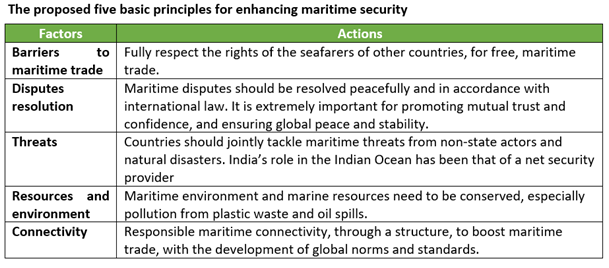Friday, 13th August 2021
Minority Institutions and RTE: NCPCR Survey
In News: The National Commission for the Protection of the Rights of the Child (NCPCR) recently conducted a Nationwide Assessment of Minority Schools.
Aim of the Report
- The aim was to assesshow the 93rd Amendment to Indian Constitution, which exempts minority institutions from otherwise mandatory provisions of the Right to Education (RTE), affected children belonging to minority communities.
Highlights of the Report
- Disproportionate Numbers
- The study highlights that 74 per cent of students in Christian missionary schools belonged to non-minority communities.
- Overall, 62.50 per cent of students in such schools belonged to non-minority communities.
- Many schools have registered as minority institutions to evade implementing RTE.
- According to the report, only 8.76 per cent of the students in minority schools belong to socially and economically disadvantaged background.
- The report notes that while Christians comprise 11.54% of India’s minority population, they run 71.96% schools, and Muslims with 69.18% minority population run 22.75% of the schools.
- Non- Uniformity in Madrasas and their Syllabi
- It found that the largest number of out-of-school children belonged to the Muslim community.
-
- Further, the syllabi of madrasas, that have evolved over centuries, are not uniform, and are “being left ignorant of the world around them”.
- Many students develop an inferiority complex, being alienated from the rest of society and unable to adjust with the environment.
- It also says that madrasas do not have any teachers training programmes.
Way Forward
- As per the recommendation of NCPCR the government must bring all such schools, including madarasas, under the purview of Right to Education and Sarva Shiksha Abhiyan campaign.
- The NCPCR also backed reservation for studentsfrom minority communities in minority schools after its survey found a large proportion of non-minority students studying in the same.
- There is a need to review the exemption made under RTE with respect to minority institutions.
Source:
GSLV-F10 failure
In News
Recently, ISRO could not accomplish the mission to launch earth observation satellite EOS-03 into the intended orbit.
About the News
- Chronology of the events: About five minutes into the launch, the flight of GSLV-F10, which was carrying an earth observation satellite EOS-03, deviated from its scheduled trajectory.
- The first and second stages of the rocket had functioned normally and detached. But the upper stage, powered by a cryogenic engine fuelled by liquid hydrogen and liquid oxygen at very low temperatures, failed to ignite.
- The rocket lost the power to carry on and its remains, along with that of the satellite, most likely fell off somewhere in the Andaman Sea.
- The EOS-03 satellite: The EOS-03 was launched with the aim of boosting India's capabilities of disaster management and mitigation as it would have enabled near-real-time monitoring of natural disasters like floods and cyclones that have become common in the Indian subcontinent.
- The satellite had the capability of imaging the whole country four to five times on a daily basis, sending in key data related to weather and environmental change to different agencies.
- Possible Consequences: Apart from the loss of a crucial satellite, it is likely to impact the schedule of some big-ticket future missions as well, though the ISRO has not yet disclosed how serious the malfunctioning was that led to the failure.
- This failure is a big cause of worry for the NISAR mission, collaboration between NASA and ISRO for a joint earth-observation satellite, as it involves the GSLV Mk-II rocket.
- History of Cryogenic stage: Problems in the cryogenic stage of this rocket are not new. A similar issue had led to the failure of GSLV-D3 as well in April 2010. The GSLV Mk-II rocket has carried out six successful launches, all using that same indigenously developed cryogenic engine in the upper stage, the last one in December 2018 which deposited GSAT-7A, a communication satellite, into its orbit.

What is GSLV Mk-II?
- Geosynchronous Satellite Launch Vehicle Mark-II (GSLV Mk II) is one of the largest launch vehicles developed by India. A fourth-generation launch vehicle, it is a three-stage rocket with four liquid strap-ons. The third stage, that led to Isro's recent failure, consists of the homegrown Cryogenic Upper Stage.
- While the first stage of the GSLV is solid fuel, the second is liquid fuel and the third the cryogenic According to Isro, a cryogenic rocket stage is more efficient and provides more thrust for every kilogram of propellant it burns.
- The GSLV has the capability of placing up to 5 tonnes of payload into Low Earth Orbit (LEO), and 2.5 tonnes in the Geosynchronous Transfer Orbits.
Sources:
In a first, tiger and elephant census to be conducted together in 2022
In News
For the first time in India, tiger and elephant census will be done in convergence from year 2022.
About the News
- New Method: India will embark on a first scientific estimation of its elephant population next year, using DNA analysis of dung samples, camera trapping, and statistical modelling, following a process similar to that used in the quadrennial tiger count.
- Counting together: The Environment, Forest and Climate Change Ministry released the population estimation protocol to be adopted for the project. This will also be the first time that tigers, leopards and elephants will be counted together.
- The local communities and indigenous people in the conservation of elephants will be involved and a bottom-up approach will also help in minimising human-elephant conflict.
- Current Status: India does have an elephant census, but this is largely a headcount of elephants in various elephant habitats conducted by state forest departments. The last one was carried out in 2017 and concluded that India has at least 27,000 elephants.
- Proposed Technique: According to the new estimation methodology, the process involves rigorous statistical analyses of ground data on animal signs, human impacts, habitat attributes and absolute density. The process will involve three phases: ground surveys, analyses of remotely sensed data and camera traps.
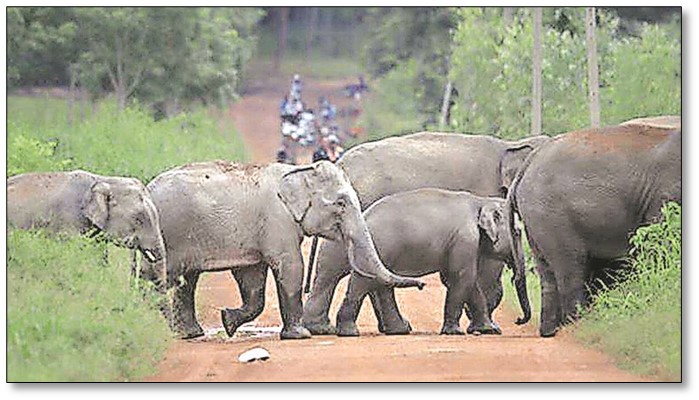
Need for adopting new methodology
- Expanding Elephant distribution: The 2017 elephant census results revealed that the distribution range of elephants in the country had expanded and many states that never had any elephants were recording elephant presence.
- Elephant populations were reported for the first time from Manipur, Mizoram, Bihar, Madhya Pradesh, Haryana, Himachal Pradesh and Andaman and Nicobar.
- Status of Elephants: Asian elephants are listed as “Endangered” on the IUCN Red List of threatened species. The current population estimates indicate that there are about 50,000 -60000 Asian elephants in the world. More than 60 % of the population is held in India.
- Overlapping areas: The reason for adopting a common survey is that most of the area adopted by both the mammals are 90% overlapping, for which if the process is standardised will save cost for the government. Regions in Kerela like Periyar National Park, Anamalai in Tamil Nadu, Kaziranga in Assam etc. have overlapping areas of habitat.
- Uniformity: There is need to bring uniformity across all the states for the process to be followed which currently is done by the state forest departments.
Sources:
Image of the Day - Cave lion
This is the image of 40,000-years-old frozen mummy of an extinct cave lion cub. Researchers in Sweden claim that the cub, nicknamed Sparta, is probably the best-preserved Ice Age animal ever uncovered. Her teeth, skin, and soft tissue have all been mummified by the ice. Even her organs remain intact.

Source:
IPCC Sixth Assessment Report (AR6)
In News
The Intergovernmental Panel on Climate Change (IPCC) released the first part of its Sixth Assessment Report (AR6) titled ‘Climate Change 2021: The Physical Science Basis’.
Background
- At regular intervals, the IPCC prepares comprehensive Assessment Reports of scientific, technical, and socio-economic information relevant to the understanding of human-induced climate change, potential impacts of climate change and options for mitigation and adaptation.
- Five Assessment Reports have been completed in 1990, 1995, 2001, 2007 and 2014.
- Present report is the Working Group I contribution to the AR6. Working Group-I deals with the scientific basis for climate change. Working Group-II looks at the likely impacts, vulnerabilities, and adaptation issues, while Working Group-III deals with the mitigation of climate change.

Key Highlights of Present Report
- Rising global temperature: The rise in average surface temperature of the Earth will cross 1.5 degrees Celsius in the next 20 years, and 2°C by the middle of the century. Thus, even if emissions are brought to net-zero by mid-century, there will be an “overshoot” of the 1.5°C limit by 0.1°C.
- The threshold of 2°C will be exceeded during the 21st century without deep emissions cuts in the coming decades.
- The last decade was hotter than any period of time in the past 125,000 years. Global surface temperature was 1.09°C higher in the decade between 2011-2020 than between 1850-1900.
- Carbon dioxide (CO2) concentrations are the highest in at least two million years. Humans have emitted 2,400 billion tonnes of CO2 since the late 1800s. Most of this can be attributed to human activities, particularly the burning of fossil fuels.
- Exhausting Carbon Budget: For a 66% chance of limiting warming to 1.5C, the AR6 reports that the world has a remaining carbon budget of 360GtCO2 – or nine years of current emissions.
- Carbon budgets are a simplified way to measure the additional emissions that can enter the atmosphere if the world wishes to limit global warming to levels such as 1.5C.
- The relative efficiency of sinks — the earth’s natural cleaning system, the oceans, forests and soils, will go down in the coming years as emissions continue to rise. Currently, oceans, land and forests together absorb some 50% of the emissions that we release into the atmosphere each year.
- Report says that we cannot bank on the sinks to clean up the emissions in the future at this same rate. This means the ‘net zero’ plans of countries will have to be revisited.
- Sea-level rise (SLR): Since 1901, global mean sea level (GMSL) has risen by about 0.20m and it is doing so at an “accelerating” rate. The rate of GMSL rise in the 20th century was faster than any other century in the last three millennia and that this rate has increased since the 1960s.
- Major contributors to SLR are the thermal expansion of seawater and mass loss from glaciers and ice sheets and changes in land water storage. Mass loss from ice sheets has become an increasingly important factor over the past several decades – 27% over the period 2006-18.
- The Arctic Sea ice is the lowest it has been in 1,000 years.
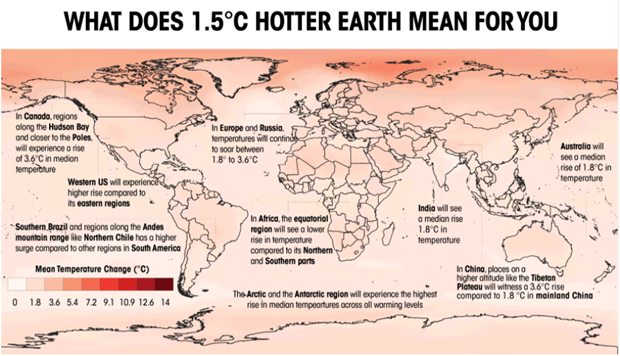
- Extreme Events: Every additional 0.5 degree of warming will increase hot extremes, extreme precipitation, and drought.
- Human influence is the main driver of hot weather extremes (which have become more frequent and intense since the 1950s). These extremes would have been unlikely without the anthropological factors. It has also been the main driver of ocean warming.
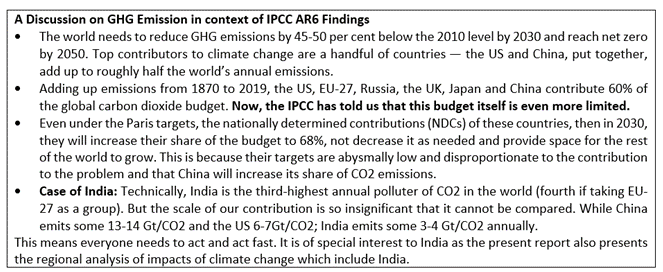
What is the significance of IPCC assessment reports for India?
- Even though the IPCC AR assessments are global in scale, it gives a picture of what are the climate change realities for India. So, it will help India realise where its development and environment conservation trajectories are moving vis-à-vis these climate change realities.
- Since, in the past few years, extreme weather events such as floods and droughts have been occurring with increased frequency and intensity, the report will give the trend for the coming years for India, which is considered a crucial player in the global climate change debate.
- India has also had a paradigm transition since the Paris Agreement. Although voluntary, declared through the NDCs, India now has some form of a target.
- Now, the Working Group I report will help India mark its trajectory against the climate reality. The Working Group II report will help identify vulnerabilities and adaptation possibilities. And the Working Group III report will help India fine-tune its mitigation strategies.
Conclusion
Climate change demands effective global leadership. Climate change is yet one more global crisis that needs a global response — we cannot win this without cooperation of all and this needs climate justice for all. Climate change is also a great leveler — today, not only the poor are hit by extreme weather events but also the rich. So, we need to act. And act fast and together. Science has spoken. Now action must follow.
Question: What are the key highlights of IPCC AR 6? Explain its relevance with respect to India’s future.
Source:
- In-depth Q&A: The IPCC’s sixth assessment report on climate science
- Climate Change 2021: the Physical Science Basis, the Working Group I contribution to the Sixth Assessment Report
- IPCC report forecasts a future of severe weather
- Explained: What are IPCC assessment reports, and why are they significant in understanding climate change?
- Ten highlights of the IPCC report
- Turn of the tide in 120 years: Past, present and future of climate
- IPCC climate report: Profound changes are underway in Earth’s oceans and ice
- Explained: Status check on world climateIPCC Sixth Assessment Report: Climate Change 2014 (AR6)IPCC shows what our planet will be like as climate change continues
- IPCC’s new report on climate change is a call to action
- Humans have caused almost 100% of global warming, says new IPCC report
- 1.5°C warming in 20 years: What does IPCC warning mean
- [Explainer] IPCC AR6 and its relevance to India
This Day in History - Fidel Castro
On August 13, 1926, Cuban political leader Fidel Castro, who transformed his country into the first communist state in the Western Hemisphere, was born. Castro became a symbol of communist revolution in Latin America. Beginning in 1958, Fidel Castro and his forces began a campaign of guerrilla warfare which led to the overthrow of Cuban dictator Fulgencio Batista. As the country's new leader, Castro implemented communist domestic policies and initiated military and economic relations with the Soviet Union that led to strained relations with the United States.

Sources:
FEMBoSA
- Context: The Election Commission of India has handed over the Chair of Forum of the Election Management Bodies of South Asia (FEMBoSA) to the Election Commission of Bhutan for 2021-22.
- The objectives of the Forum are to promote contact among the Election Management Bodies (EMBs) of the SAARC countries; share experiences with a view to learning from each other and cooperate with one another in enhancing the capabilities of the EMBs towards conducting free and fair elections.
- FEMBoSA was established at the 3rd Conference of Heads of Election Management Bodies (EMBs) of SAARC Countries held at New Delhi in 2012.
- With its eight members (besides ECI, the other 7 members are EMBs from Afghanistan, Bangladesh, Bhutan, Maldives, Nepal, Pakistan and Sri Lanka), FEMBoSA represents a very large part of the democratic world and is an active regional association of EMBs of South Asia.
- The annual FEMBoSA meeting is held by rotation among the members.

Source:
- CEC inaugurates 11th Annual Meeting of the Forum of the Election Management Bodies of South Asia (FEMBoSA) for 2021
- ECI to Host 10th Annual Meeting of The Forum of the Election Management Bodies of South Asia (FEMBoSA) & an International Conference on ‘Strengthening Institutional Capacity’
Picture Source:
Khudiram Bose
- Context: death anniversary of Khudiram Bose.
- Bose was born in 1889, in Midnapore district of West Bengal.
- Khudiram Bose, an epitome of fearlessness, was one of the youngest revolutionaries of the Indian Independence movement.
- He showed an inclination towards revolutionary activities and actively participated in several protests against the British when Bengal was partitioned in 1905.
- He joined the Anushilan Samiti, an early 20th century organization that propounded revolutionary activities in Bengal.
- He was arrested for trying to assassinate British judge Douglas Kingsford, and was executed for the same on August 11, 1908, in Muzaffarpur jail in Bihar at the age of 18.
- Bose and his colleague Prafulla Chaki had conspired to kill the judge as his judgments were seen as biased, harsh and unjust against Indian nationalists.

Source:
Image Source:
Kaziranga National Park: Assam
- Context: Kaziranga has become the first National Park in India to have been equipped with satellite phones for boosting anti-poaching measure.
- It is the oldest park in Assam covers an area of 430 Sq kms along the river Brahmaputra on the North and the Karbi Anglong hills on the South.
- It is the single largest undisturbed and representative area in the Brahmaputra Valley floodplain.
- It is a UNESCO World Heritage Site and is famous for the Great Indian one horned rhinoceros.
- It was declared as a National Park in 1974.
- It was declared as a Tiger Reserve in 2007 and is recognized as an Important Bird Area by Bird Life International.
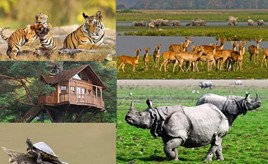
Source:
- Kaziranga guards equipped with satellite phones
- Kaziranga National Park
- Kaziranga National ParkKaziranga National Park
Image Source:
Kerala’s Bio bubble model for Safe Tourism
- Context: With the re-opening of tourism centres in Kerala, the state Tourism Department has rolled out a "bio-bubble" model to protect tourists from the infection.
- “Bio-bubbles" are sanitized, safe and secure environments and people within them who are likely to come into contact with tourists are vaccinated.
- The model aims to create protective layers of mostly vaccinated service providers to receive and host the tourists.
- Only those who have had at least the first dose of the Covid-19 jab or possessing a negative RTPCR test certificate taken before 72 hours of reaching the state, are now being allowed.

Source:
- Kerala rolls out 'bio-bubble' model to revive tourism. Check details
- Kerala rolls out ‘bio-bubble’ model for safe tourism
Image Source:
Criminalization of Politics Must Be Curbed
Essence: The Supreme Court has questioned the increase in criminalization of politics, this time through an attempt by politicians to flout disclosing criminal backgrounds before the Bihar elections. On the other hand, political parties evade the situation by pointing out at Winnability and the maxim- “innocent until proven guilty”. It is true that some cases are registered due to vendetta politics but the article points out the dubious standards of the rules for politicians and common citizens when it comes to political rights after being undertrial. The ECI has suggested some safeguards for good along with having fast track courts for resolution of such cases.
Why you should read this article?
- To understand the innovative alternatives to manage the menace of criminalization of politics.
- To analyze the statistics of increasing numbers of criminal cases being registered against politicians.
Source:
Parliament is abdicating its oversight role
Essence: The articles argues that the Parliament is ineffective in all its functions. The monsoon session, the fourth straight session to be curtailed early, did not discuss the most important issues such as farmers protests, Chinese incursion, Pegasus spyware etc. The Lok Sabha and Rajya Sabha worked for just 19% and 26% of scheduled time respectively. The scrutiny over the bills decreased as no bills were referred to the Select Committees, crucial bills were passed without any discussion and just one debate in Rajya Sabha and none in the Lok Sabha on policy issues. As the new Parliament building will be inaugurated in the next year (70th anniversary of Parliament), the speeches to celebrate shall not be empty words and the parliamentarians must act now.
Why you should read this article?
- Functioning of the Parliament is a part of Mains General Studies Paper II.
- The article has ample amount of data, facts and dimensions to show that the Parliament is ineffective in all its functions.
Source:
How e-RUPI can transform government’s welfare schemes
Essence: e-RUPI brings the ease and simplicity of UPI to the social security platform of DBT and will help the government sharpen targeted welfare programs. It has wider applicability in private sector CSR programmes, Covid vaccination centres (CVCs), Public Distribution System (PDS) and fertilisers schemes, etc. e-RUPI could break the policy logjam and will enhance business efficiency, simplicity, transparency, and accountability in various government programs. All banks, small and big, NBFCs, non-bank PPI issuers, and telcos may be allowed to issue it later. e-RUPI opens a world of opportunities to the government, people, and businesses to provide, avail and pay for services seamlessly.
Why should you read this article?
- To get an overview of e-RUPI and how they can transform government’s welfare schemes.
- To know their application across various sectors and also area of welfare schemes and how they could help in breaking policy logjam?
Source:
Community Wildlife Conservation: Success Story
Namibia: protecting the black rhino
- Namibia is one of the best-known examples of where community-based conservation has really worked for black rhinoceroses.
Methodology deployed
- 30 years ago, the NGOIntegrated Rural Development and Nature Conservation began to pay local people to protect wildlife.
- Following independence in 1990, government decided to devolve the rights to use and benefit from the wildlife to the local people. This transformed attitudes to conservation and was key to the country's success.
- Community ownership made illegal poaching feel wrong and irrational as the wildlife helps generate profits.
- Local communities run small tourism enterprises, sell licences for tourism and trade in handicrafts and cosmetics based on natural products.
- An insurance scheme ensures local people are compensated for the damage caused by the wildlife
Outcome
- Since then, black rhino populations have continued to increase, from 1,435 in 2007 to 1,750 in 2012.
- Namibia is not alone in adopting this approach. In the Andes, money from fibre has led some indigenous communities to share their grazing land.
Lessons
- Ensuring local communities benefit from wildlife is key to successful conservation in the long term and can help to fight the illegal wildlife trade.
Source:
Share the article
Get Latest Updates on Offers, Event dates, and free Mentorship sessions.

Get in touch with our Expert Academic Counsellors 👋
FAQs
UPSC Daily Current Affairs focuses on learning current events on a daily basis. An aspirant needs to study regular and updated information about current events, news, and relevant topics that are important for UPSC aspirants. It covers national and international affairs, government policies, socio-economic issues, science and technology advancements, and more.
UPSC Daily Current Affairs provides aspirants with a concise and comprehensive overview of the latest happenings and developments across various fields. It helps aspirants stay updated with current affairs and provides them with valuable insights and analysis, which are essential for answering questions in the UPSC examinations. It enhances their knowledge, analytical skills, and ability to connect current affairs with the UPSC syllabus.
UPSC Daily Current Affairs covers a wide range of topics, including politics, economics, science and technology, environment, social issues, governance, international relations, and more. It offers news summaries, in-depth analyses, editorials, opinion pieces, and relevant study materials. It also provides practice questions and quizzes to help aspirants test their understanding of current affairs.
Edukemy's UPSC Daily Current Affairs can be accessed through:
- UPSC Daily Current Affairs can be accessed through Current Affairs tab at the top of the Main Page of Edukemy.
- Edukemy Mobile app: The Daily Current Affairs can also be access through Edukemy Mobile App.
- Social media: Follow Edukemy’s official social media accounts or pages that provide UPSC Daily Current Affairs updates, including Facebook, Twitter, or Telegram channels.



